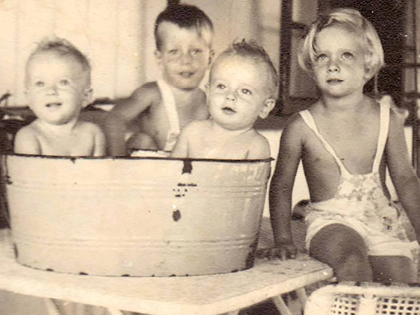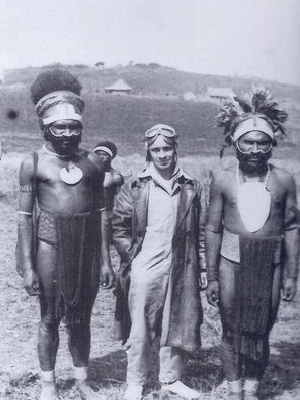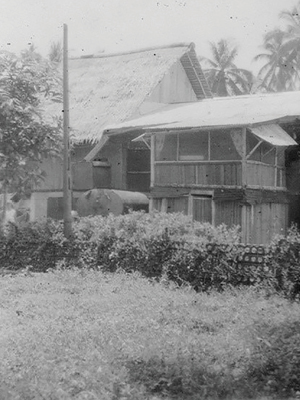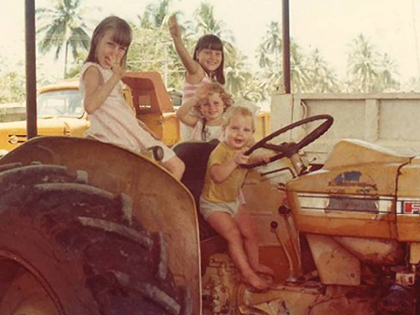Humans of Aura
Robert Parer, CMG, MBE: A man who made a difference
Robert and Meg Parer are residents of Kingsford Terrace Corinda. Robert Parer, CMG MBE, was born in PNG and he and Meg raised their family on plantations. Meg reveals Robert is considered a hero in the area where they lived and is called Papa Bilong Olgeta (the Father of Everyone). This is Robert’s remarkable story.
The lure of gold led the first of my Parer kin from near Barcelona, Spain, to the goldfields of Victoria in the 1850s. Many Parers soon followed and invested their first savings into hotels in Melbourne and in less than 40 years their extended families owned more than 35 hotels in the CBD.
Parer families were particularly proud of Parer’s Crystal Café Hotel, a splendid multi-storey building in Bourke Street, built in 1886. Leavitt’s Jubilee History of Victoria described it as the leading hotel in the Southern Hemisphere.
In 1928, my father Bob Parer followed his brother Ray to New Guinea as gold had been found high up inland from Lae and as there was no way a road could be built, aircraft were needed. Uncle Ray was one of the first to provide an airline service and was the greatest flying man New Guinea has known. Dad was his engineer.
Then Dad got ‘gold fever’ and decided to go out on his own mining in a terribly isolated and hostile jungle terrain at Black Cat between Salamaua on the coast and Wau in the mountains.
In 1933 he married my mother Mollie. It was so tough for her to get to Black Cat where she stayed for nine months in a primitive house with dirt floors and no doors. She didn’t even see another woman in that time. But a lack of gold led them to Upper Watut where it was more civilised as it had a short airstrip. They stayed for three years.
In 1937 Dad left behind my pregnant Mum and went off to explore the Sepik coastal area near Aitape. Kevin, another flying uncle, landed one day and took one look at Mum and insisted she squeeze into his two-seater plane and he somehow got her to Wau. Two weeks later she gave birth to me and my twin sister, Carolin.

We were born six weeks premature and weighed two pounds each. The doctor took one look at us and declared there was no way we would survive. Incredibly, a specialised nurse crafted ‘humidicribs’ for us and fed us via eye-droppers. This amazing woman kept us alive. Mum didn’t see us for 10 days. Dad was still looking for gold when he received word of our births and got to Wau.
Eventually Mum, Carolin and I went by plane to Brisbane and on to Maleny staying with Dad’s brother Tony who was the doctor in charge of the Maleny Hospital. While Mum was in Australia, Dad decided to give gold mining away and had gone to Wewak in the Sepik district. He had bought a block of land on Wewak Hill and built the first private house out of bush materials that was ready when Mum, Carolin and I came back from Australia.
Dad established a huge refrigeration plant in Wewak where he could store 10 tonnes of freezers shipped from Australia to store food products. All was going well with Dad supplying the Maprik miners and Kevin flying in their goods. Then in 1939 all the ships that had been coming to New Guinea were sent to Europe to help the British war effort. That was the end of Dad’s business in Wewak.
Dad headed off to a gold mining area on Bougainville Island, 800km away leaving Mum alone again, and now with another set of twins, Sheila and Ian, who were born in 1940, the first Australians born at Wewak. Despite everything, my mother adored life in Wewak.


Robert Parer with his twin sister Carolin and younger twin siblings Sheila and Ian, with their parents Bob and Mollie.
My mother was a strongly resilient individual: a remarkable and extraordinary lady whose astute intelligence and wicked sense of humour accompanied her adaptability and energy.
Uncle Kevin came to Mum’s rescue yet again as he decided that with Dad away and war looming in the Pacific, that we couldn’t stay any longer in Wewak. Kevin ended up ‘kidnapping’ me in his Dragon aircraft and I remember it well - I was only four and half. The Wau airstrip sloped and in those days planes didn’t have brakes and I remember someone rushing out as soon as the plane stopped to put chocks under the wheels to stop it rolling away. Later he picked up Mum and the other three children.
We stayed with Kevin’s family until war was declared and the Government announced all the Australian women and children had to get out of the territory. The SS Katoomba left Port Moresby on December 17, 1941, for Australia with about 800 women and children on board. We all slept on the decks and everyone was sick as the vessel zig-zagged south because of all the mines. It was such a difficult time for all those brave women who had to leave their homes with no money and little clothing. But I think the kids had a great time – there were lots of other Parer kids on the ship. I remember we had Santa onboard and he gave me softdrink as my present – I’d never even seen softdrink before.

On January 21, 1942, Uncle Kevin (pictured) became the first person killed by the Japanese in New Guinea at Salamaua airstrip. In March his wife Nance gave birth to a girl, Helen.
We eventually got to Melbourne and Dad still didn’t know what had happened to us and Mum didn’t know what had happened to him. Dad had been gold mining inland and got a message to go to see the District Officer at Kieta but when he got there he was shocked to discover all the staff, scared by the Japanese bombings, had fled. He met the District Officer of Buka, Jack Read, there who got Dad to blow open the government safe and they destroyed the files and codes in case the Japanese arrived.
Dad was able to get his gold nuggets from the district office and he found a 20-foot pinnace boat he used to escape with three others for the 800km trip to Tulagi in British Solomons. As lots of Japanese aircraft and ships were around, they had to be careful.
Eventually he made his way by tanker to Sydney and arrived in May 1942. He had been very lucky to get out of Tulagi as it was taken by the Japanese on May 3. Only then did he find out where we were and went by train to meet up with us in Melbourne.
I was a wild little fellow and made friends with the local street kids and they took me to the Moonee Valley races where I spent the day eating discarded pies. The police picked me up at some stage and I was wearing a man’s waistcoat full of race books. My poor Mum!

Dad (pictured with Mollie) worked in aviation at Essendon Airport and they offered him a big job in Brisbane as the superintendent of aircraft production at Archerfield in Brisbane. He had staff of 2,000 women and some young boys.
We moved to Brisbane in 1943 and later bought a large house at 59 Heath Street, East Brisbane, which is now the headmaster’s residence for ‘Churchie’ Grammar School. I was having a great time going to war time dumps and swimming in the muddy Norman Creek. Mum was too busy to know what I was doing as she was looking after her own mother and my other sisters Teresa and Shelly had been born. She never stopped working with six children.
In 1950 my cousin Kevin and I went to Nudgee Junior College boarding school. The Christian brothers whacked the hell out of me and I started learning. Actually, I loved it there, not the beatings but the camaraderie. The next year I went to Nudgee Senior with four other older Parer cousins. After doing Junior, Kevin and I went to Gatton Agricultural College.
In June 1954 Dad had signed the lease for three coconut plantations in New Guinea on the north coast near Aitape. Dad had never run a plantation but his brother Bernard, a planter from Rabaul, did a survey and made detailed instructions for Dad to follow and was sure they would be profitable. So in July Dad took over the plantations and his cousin Cyril, also a planter from Rabaul, met him there and built a hot air dryer for the coconut flesh (copra). It worked much better than the smoke dryers on the plantations.
Dad came back to Brisbane in December and said, “We’re all going up to Aitape for Christmas.’’ Even though Kevin and I were loving Gatton and our studies, we both decided we wanted to work on the plantations. Our family flew up to Wewak and stayed there until the Catholic Mission Wewak’s MV Marova picked us up for the boat trip to Aitape. At Aitape we were taken ashore through the wild surf by the plantation staff in 45-foot canoes.

We all stayed together in the bush material house (pictured) on the Tadji plantation. After a wonderful holiday Mum and my siblings returned to East Brisbane at the end of January. I stayed on at Tadji and Dad stayed temporarily.
Australian Franciscans Friars had come to Aitape in 1946 to open up mission stations along the coast and inland. My uncle Fr Ferdy Parer had a station in the mountains near Nuku and it was so nice to see him when he came to Aitape. We were so fortunate as all the Catholic mission people were so caring and really wonderful company.
Later Kevin returned to Brisbane to study medicine. After becoming a doctor, he joined a practice at Lae and was there for 10 years and known to be one of the best doctors around.
In 1955, when I was about 18, I built a two-storey house at St Anna Plantation, which was closer to Aitape and near the Franciscan Friary. Plantation workers helped me and used material mostly left over from the war.
The family company was doing very well as we got production up to 60 tonne of copra a month but in the late 1960s the price of copra plummeted so we decided to go into cocoa. We bought 120 hectares from the Catholic Mission inland 4km beside the Raihu River and we cleared the jungle by hand as we had no heavy equipment at that time. Road and drains were put in and we planted coconut trees first as shade for the cocoa.
Meanwhile, we had bought an allotment in Aitape Town and established a trade store. There was only one other store in the area and ours began growing then we built a supermarket and hardware store. Our biggest problem was getting cargo and supplies into the area as there was no connecting road and no wharf. We had to unload cargo using canoes to get through the rough surf and in the process would lose so much cargo.

I got a letter from the Administrator of Moresby informing me I’d been accepted to be on the government’s District Advisory Council. Here I was a young fellow in my early 20s and they would send a single-engine plane every three months to collect me. I grew into the role and was on the council for many years. I’d bring up what was required in the area or what the people wanted such as the wharf. I fought for the wharf for years and the PNG Harbours Board eventually built it in 1974 and it made a huge difference. Other issues such as health care would be discussed at council.
After the wharf was built we were able to provide bulk fuel with a pipe coming from the ships and we opened a service station. In the 1960s Lae started establishing a lot of factories and we were their agent. Cargo now came in containers or on pallets and we had forklifts so did not have much in the way of damaged goods. We were distributing to missions and hundreds of village stores and to high schools and government departments. Aircraft was able to bring supplies to the inland Government Stations at Lumi and Nuku.
Our family business was going well indeed and our monthly ship was bringing in 550 tonnes of cargo. I was the general manager. I got my business know-how from Dad. He was an amazing man in fact the wisest man I have ever known.
At first we were using war-time trucks and jeeps and then obtained two bulldozers and two graders. As the government had received funds for building the road towards Wewak we purchased two new front loaders and four six-tonne tipper trucks and built the road.

I met Meg through my sister Sheila. They had nursed together at Brisbane's Mater Hospital and one day Sheila brought a few girls over to the family home at East Brisbane for a bit of a party and I was back in Brisbane on holiday. I took one look at Meg – wow, she was such a beautiful girl. We didn’t go out or anything but then she went off travelling and working overseas for 18 months. We met again in Brisbane when she returned so I invited her out and that was it!
We married in 1970 and Meg returned to PNG with me. She arrived to a house without any windows, just flywire all round. But as she would say it was better than what my mother had arrived to!
Just like my mother, Meg’s energy and resilience came to the fore when needed. Meg’s adaptability, optimism and acceptance of this new life in a remote coastal tropical area with all its daily trials amazed me. She charmed everybody in the area with her friendliness and generosity of spirit, as well as her work ethic and she became legendary in the Aitape district over the decades.
 We started our family and Meg would return to Brisbane to have her babies at the Mater Mothers where she had been a tutor sister. Our first baby Anna-Maree died of cot death at our St Anna home. hen we had another three girls – Genevieve, Rebecca and Emma – and a boy, Michael.
We started our family and Meg would return to Brisbane to have her babies at the Mater Mothers where she had been a tutor sister. Our first baby Anna-Maree died of cot death at our St Anna home. hen we had another three girls – Genevieve, Rebecca and Emma – and a boy, Michael.
The house that I had built burned down in 1978 because of an electrical fault in a 240V wall fan. Lucky it was day time as it was gone within 20 minutes. We built a beautiful new house from bricks made from crushed coral that took two years to finish.
A massive tsunami struck on July 17, 1998. Aitape Town and our place had been protected but along the coast west of Aitape everything was gone, wiped out by the 15m high waves.
There would be few places anywhere in the world where so many people were as vulnerable with all the residents living between the sea and the Sissano Lagoon which was 40km long and 5km wide.
Most of the houses in the villages of Malol, Arop, Warapu and Sissano where 12,000 people had lived were gone. Around 2,000 people died, another 1,000 were seriously injured and 10,000 were displaced and had to go inland through the jungle to make camps there. We had no idea until later in the day.
The Aitape Government had no money or fuel so we supplied for free 40 tonnes of necessary food and all the fuel required for every boat available to take the supplies to the disaster area.

Aitape Township was a peaceful place for our children to grow up. They loved it and still call it ‘home’. Meg taught our four children by correspondence and in the afternoon they went to the Community School. They were the only non-indigenous children there learning local traditions like sing-sings and the beautiful ways of Papua New Guinea culture. Like everything Meg does, she really shone at this. She is a natural teacher, calm, patient and clever.
When our children went to boarding school in Brisbane, Meg volunteered to do tutoring and health care at the local St Ignatius High School. Many students, when they first came to high school, could hardly speak English so Meg would take the tailenders out and bring them up. She saw some of her students become judges, doctors, engineers and teachers over the 20 years she worked there.
The PNG Harbours Board never made any funds available for maintenance of their wharf. We did the maintenance for free and kept it open all those years but when we sold in 2007 to retire back in Brisbane no one did maintenance and now there’s no shipping service at all. Sadly, it was the same with the airstrip, our family company kept it open and maintained it for free and there was a wonderful service with six flights a week and now no air service at all. So the people of Aitape are having a really bad time. It is shocking really as most services have gone back 30 years. But the people are too nice to complain.
On Facebook the locals are always asking me to come back! In 1996 I was awarded an MBE (Member of the Order of the British Empire) from the Queen for service to the people of PNG and only because the local people wanted me to get it and requested it through the Siau Local Government Council.
Then some years later I received another Queen’s award, the Companion of the Order of St Michael and St George (CMG). I went to Moresby to receive this from the Governor-General. This was for services to commerce, industry, education and the community of Aitape.
Over the years I had got the Scouts going and I was the Torricelli Area Scout Commissioner which covers the whole of West Sepik. Our company organised and financed an annual soccer tournament with 700 registered players, both male and female. The grand final has been played on Robert Parer Oval, Aitape.


Since returning to Brisbane I have just been involved in daily life and family including grandchildren. Every day I spend about two hours on Facebook posting news from the two PNG newspapers and news from around the world on my Aitape Blog to about 4,500 followers, PNG locals, who have very limited access to news.
What I miss most is the Papua New Guineans. They are truly beautiful people, strong and passionate people with a deep love of stories and family. I still have a powerful bond with them. It has been an amazing life and Meg and I are truly grateful for everything we have experienced.
At Aura Holdings we feel privileged to have so many residents who have had distinguished and successful careers that made a real difference to others. A big thank to Robert Parer, for sharing his story of his remarkable family and his own incredible achievements. Robert and his wife Meg are residents of our Brisbane community, Kingsford Terrace Corinda.


